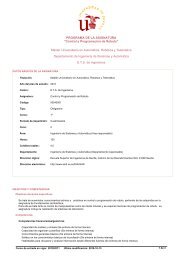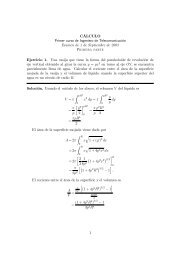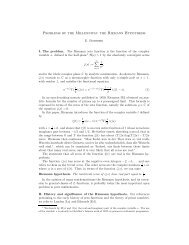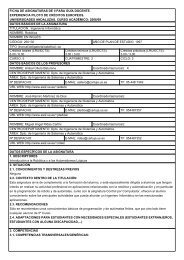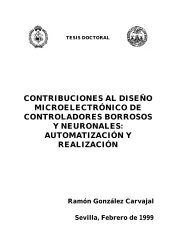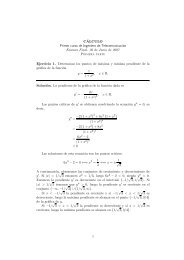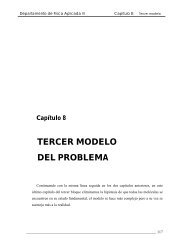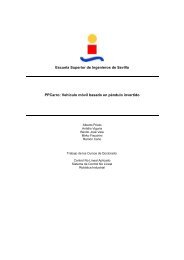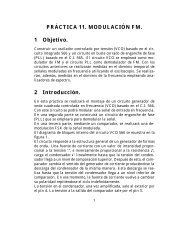A control strategy for the cart-pendulum system Abstract 1 ...
A control strategy for the cart-pendulum system Abstract 1 ...
A control strategy for the cart-pendulum system Abstract 1 ...
You also want an ePaper? Increase the reach of your titles
YUMPU automatically turns print PDFs into web optimized ePapers that Google loves.
As ϕ is not definite, H d is not a Lyapunov functionin <strong>the</strong> whole state space. Consider now <strong>the</strong> followingLyapunov function candidate:V = ϕ(x 1 ,x 2 )(H d − 1/3)(= ϕ(x 1 ,x 2 ) − 1 3 cos3x 1 + 1 2 x2 2 − 1 ). (10)3Notice that V ≥ −2/3 and continuous. Never<strong>the</strong>less,V is not differentiable at <strong>the</strong> switching curve of (8).Outside this curve,This implies that:˙V = −ϕ 2 x 2 2 cos 2 x 1 ≤ 0• V is a Lyapunov function in <strong>the</strong> region Ω inside <strong>the</strong>central closed curve of Fig. 2. This closed curve is<strong>the</strong> level curve V = 0.• The switching curve in (8) is attractive.In fact, a sliding motion is produced along <strong>the</strong> switchingcurve. The motion inside this curve can be deducedfrom <strong>the</strong> first equation of (9). Thus, only four equilibriain <strong>the</strong> sliding motion are possible (with x 1 ∈ [−π,π]):E 1,2 : (±π/3,0) and E 3,4 (±π,0). Besides, outside <strong>the</strong>sliding curve <strong>the</strong>re are more limit sets: <strong>the</strong> maximuminvariant set in Ω <strong>for</strong> which ˙V = 0 is (±2π/3,0) ⋃ (0,0),being all equilibrium points. The latter is <strong>the</strong> desiredequilibrium while it is clear that <strong>the</strong> <strong>for</strong>mer ones areunstable. There<strong>for</strong>e, <strong>the</strong> only problematic points areE 1,2 and E 3,4 .curves. It can be seen that <strong>the</strong> undesirable equilibriumpoints E 1,2 and E 3,4 still exist but <strong>the</strong>y are outside<strong>the</strong> sliding manifold and, since <strong>the</strong>y are unstable,<strong>the</strong>y do not preclude <strong>the</strong> almost-global stability property.Never<strong>the</strong>less, this property is not proved yet. Noticethat with <strong>the</strong> choice (12), <strong>the</strong> Lyapunov functioncandidate is continuous along <strong>the</strong> dotted curve of Fig.3. But now, function ϕ ε introduces new switching linesat x 1 = ±π/3 (segments AB and CD in Fig. 3). Function(12) is not continuous at <strong>the</strong>se segments and <strong>the</strong>analysis must be per<strong>for</strong>med carefully.In <strong>the</strong> following, it will be proved that, <strong>for</strong> smallenough ε, when <strong>the</strong> <strong>system</strong> reaches <strong>the</strong>se points of discontinuity<strong>for</strong> (12), <strong>the</strong> trajectory evolves towards <strong>the</strong>origin. Due to <strong>the</strong> symmetry of <strong>the</strong> problem only <strong>the</strong>case of x 2 > 0 will be considered. When <strong>the</strong> <strong>system</strong>starts on <strong>the</strong> upper half of segment AB as x 2 > 0 itwill evolve to <strong>the</strong> right. In this region Ḣd > 0 and <strong>the</strong><strong>system</strong> will evolve towards <strong>the</strong> sliding curve (<strong>the</strong> dottedcurve of Fig. 3). After reaching x 1 = π it will continuefrom x 1 = −π towards x 1 = −π/3. There<strong>for</strong>e, segmentCD (with x 2 > 0) will eventually be reached. When <strong>the</strong><strong>system</strong> starts on this segment as x 2 > 0 it will evolvetowards <strong>the</strong> right but, in this region Ḣd < 0. If ε issmall enough <strong>the</strong> level curve H d = 1/3 (<strong>the</strong> solid curve)will be reached be<strong>for</strong>e reaching segment AB. Once thislevel curve is reached and crossed <strong>the</strong> <strong>system</strong> can not goout of <strong>the</strong> compact set {x : H d (x) < 1/3} where ˙V ≤ 0.1.512.2 Achieving almost-global stabilityIn order to avoid <strong>the</strong> undesirable equilibria E 1,2 andE 3,4 , <strong>the</strong> switching curve is changed from H d = 1/3 toH d = 1/3+ε with 0 < ε ≪ 1. This change is per<strong>for</strong>medsubstituting <strong>the</strong> switching function ϕ byx 20.50−0.5−1CDAB{△ −k1 if Hϕ ε = d ≤ (1/3 + ε) and cosx 1 < 0.5k 1 elsewhereThe <strong>control</strong> law is now:u = 2sin 2x} {{ } 1 +ϕ ε (x 1 ,x 2 )x 2 cos x 1 (11)} {{ }u c u dThe same analysis can be per<strong>for</strong>med with <strong>the</strong> Lyapunovfunction candidateV = ϕ ε (x 1 ,x 2 )(H d − 1/3 − ε) (12)The behaviour of <strong>the</strong> <strong>system</strong> can now be explained with<strong>the</strong> help of Fig. 3. In this figure <strong>the</strong> level curves correspondingto H d = 1/3 and H d = 1/3 + ε are plotted.The sliding motion is now along <strong>the</strong> second of <strong>the</strong>se−1.5−1 −0.8 −0.6 −0.4 −0.2 0 0.2 0.4 0.6 0.8 1x 1/πFigure 3: Level curves H d = 1/3 (solid) and H d =1/3 + ε (dotted)Since no o<strong>the</strong>r points of discontinuity exist, <strong>the</strong> followingproposition can be stated:Proposition 1. The origin of <strong>system</strong> (1) with <strong>control</strong>law (11) is almost globally asymptotically stable.2.3 Avoiding <strong>the</strong> sliding modeIn many <strong>control</strong> applications sliding modes are not admissibledue to <strong>the</strong> chattering phenomenon. The <strong>control</strong>law proposed in <strong>the</strong> previous section presents slidingmotions due to <strong>the</strong> discontinuity along <strong>the</strong> level curve3





